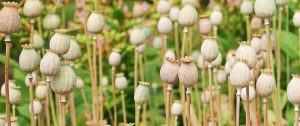By: Michaël Cousin
Translation: Lawrence Myers
Passage au crible n°101

Pixabay
On November 13, 2013, the United Nations Office on Drugs and Crime (UNODC) published its latest report and gave an alarming analysis concerning Afghanistan, the world’s top producer of poppies. Certainly, this plant with its tranquilizing properties serves as a therapeutic when it is transformed into morphine, but it becomes dangerous in the form of opium or worse, heroine. Yet, 90% of the sales of this psychotropic poppy come from this war-torn country.
> Historical background
> Theoretical framework
> Analysis
> References
For several years, the UN agency has been warning the international community about the dangers for this State of growing opium poppy. At the time of the arrival of western troops in 2001, the cultivation of land had decreased sharply, tumbling from 82,000 to 8,000 hectares. Since that time, however, the farmed surfaces have not ceased to grow, to the point of attaining nearly 209,000 hectares in 2013, while the average between 1994 and 2000 hovered around 68,150 hectares.
The UNDOC explains this development by several factors. First of all, the growth of world demand for these opiates, but also the attractiveness of the buying prices. Afghan peasants received about 160 to 203 dollars per kilo of opium, depending on its condition – fresh or dried – while the price of wheat does not exceed 0.41 dollars per kilo. Besides the financial return, drug traffickers offer a certain financial security to growers; the latter are in fact paid for their crop before even harvesting it.
In fact, the warlords allegedly only receive between 10 and 15% of the profit from the drug and therefore do not appear to be the only stakeholders in the trafficking. Even if the Afghan state has put policies into place intended to fight against cultivating opium poppy – destruction of land and products –, it would appear that 60% of elected officials remain more or less associated with this market. The UN agency also insists on the plurality of the ethnicities concerned: the Hazaras, Tajiks and the Pashtuns continue to be involved.
Otherwise, Afghanistan is now proving to be one of the most significant consumers of opium and heroin. In 2009, around 1.6 million Afghans purchased this substance (out of 35 million inhabitants) including some 120,000 intravenous heroine users. Still, in the current context, the political and sanitary conditions do not allow heroine addicts to get reliable information and sterilized paraphernalia. Yet, these injections comprise a serious vector of the transmission of HIV – without accounting for the hepatitis viruses – where the pandemic of this thirty year old virus is already strongly cracking down and where the number of users rises exponentially each year.
1. Shadow State. Drawing inspiration from the concept of the politics of the belly, William Reno
showed with the Shadow State that illegal markets develop when state authorities default. Lacking financial autonomy, the political elite then seeks fresh opportunities in a newly globalized space. This elite tries hard to control certain envied resources and to direct illicit sectors (diamonds, wood, arms, ivory and drugs) permitting them to maintain their power over the country.
2. Institutional Order. Let us understand UNODC from the basis of its institutional organization.
In this case, we shall concentrate on its system of values and behaviors, which its members must interiorize and to which they must conform, all the while forcing themselves to obtain the objectives defined by their directors.
After the deposal of Mollah Omar and the loss of his sovereign functions, the government of George W. Bush and its western allies formed a democratic Islamic republic in Afghanistan. However, this new imported state does not function like the American government would like. On the one hand, the presidential election of 2009 was tainted by numerous difficulties such as violence, a weak percentage of participation and numerous electoral frauds. On the other hand, the socioeconomic system of the Afghans remains unstructured and national security is still not assured.
For this reason the Obama administration – while it pulled out of Iraq in 2011 – continues to maintain a presence in Afghanistan. At this very moment, Kabul is negotiating with Washington so that the Pentagon will assure its security for yet another year. Still, without a viable economy, the Afghan government will remain without the means to finance its law enforcement officials. Excluding such exceptions as the New Silk Road or the oil pipeline, the White House wants to withdraw without proposing local solutions more attractive than the poppy trade.
The UN bureau report underlines this deficiency, just like certain NGOs and Afghan associations. These different organizations of course share the same economic analysis. In contrast, they do not envision the medical treatment of the adverse health effects caused by hallucinates. Therefore, the UNODC’s course of action or norm is dependent on implementation of healthcare for addicts based on proven scientific research. However, if one considered the medications proposed to heroine addicts by this agency, all of them offer limited efficiency. Conversely, the WHO (World Health Organization), NGOs and national associations recommend therapy based on methadone. Classified as an opiate, methadone is not made from soporific plants. This molecule is actually a chemical synthesis, which is ingested either orally – as a liquid solution or a gel cap – or else anally – as a suppository. In doing so, it avoids all risk of blood contamination. Moreover, it possesses a pharmacological agent that is longer than heroine, which more easily stabilizes the weaning of the consumer.
If scientists recognize the virtues of methadone, they diverge in regards to its therapeutic quality, while western states who use it, however, boast promising results. In other words, this substitution does not yet offer scientific proof of its efficiency. Obliged by its own norms, the UNODC is unsure of which position to espouse. But this indecision is proving to be detrimental to the safety of Afghans.
UNODC, « Afghanistan : Opium Survey 2013, Summary findings », 2013, http://www.unodc.org/documents/crop- monitoring/Afghanistan/Afghan_report_Summary_Findings_2013.pdf Médecins du Monde, « Guerre à la drogue ou guerre aux drogués : le quotidien des usagers de drogues afghans », 2013, http://www.medecinsdumonde.org/A-l-international/Afghanistan
Briquet Jean-Louis, Favarel-Garrigues (Éds.), Milieux criminels et pouvoir politique. Les ressorts illicites de l’État, Paris, Karthala, 2008, Coll. Recherches Internationales.
Lagroye Jacques, Offerlé Michel (Éds.), Sociologie de l’institution, Paris, Belin, 2010.




